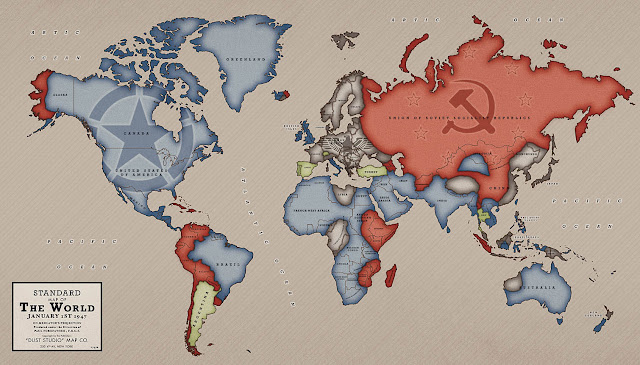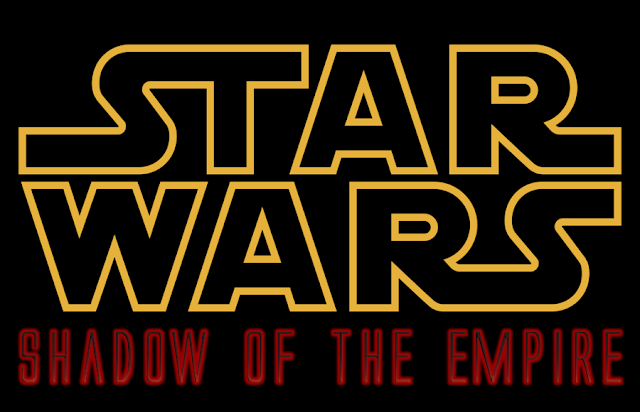A World in Dust - Timeline
A World in Dust - 1936 - 1947
1937
July: Japanese forces invade mainland China. World War II starts in Asia.
1938
March: A German military expedition led by Manfred Kreuzer returns from Antarctica under great secrecy. A U-boat bearing “vital cargo” is sent directly back to Germany.
April: The Blutkreuz Korps is formed in Berlin under the leadership of Baron Leopold von Thaler. Its goal is to study the Antarctica discoveries.
1939
September: Germany invades Poland. Great Britain, France, Australia, and New Zealand declare war on Germany. World War II starts in Europe.
1940
March: Blutkreuz Korps scientists make a breakthrough in their research, opening the “vital cargo” and waking an alien life form.
June: Paris falls and the first Battle for Britain starts the following month. Saigon becomes the new capital of the French Republic.
September: Germany, Italy, and Japan sign the Tripartite Pact. The foundations of the Axis bloc are made.
December: The war reaches North Africa. The next month, Allied troops take Tobruk.
1941
June: Operation Barbarossa is launched. The invasion of the USSR begins.
December: The Japanese navy attacks Pearl Harbor. The USA enters the war.
The Battle for Moscow occurs. Newly arrived Soviet ski troops push back the Wehrmacht.
1942
February: Japanese forces attack Darwin, Australia. A few days later, a Japanese submarine bombards Santa Barbara, CA. Mainland USA is vulnerable to attack.
April: The first American raid on Tokyo is achieved by flying Army bombers from Navy carriers and then landing in China.
August: The first American offensive begins with the Battle of Guadalcanal.
October: The Germans test fire the first V2 missile.
The Second Battle of El Alamein occurs. Allied troops inflict their first serious defeat on the Afrika Korps.
Axis Forces field test the new Panzer Kampfläufer. Mass production is slowed by difficulties importing the VK mineral from Antarctica.
November: Operation Torch begins. Allied forces land in North Africa.
Operation Uranus begins. Russians launch a massive offensive around Stalingrad. The Axis- dominated part of the city holds, thanks to the new walkers.
1943
February: The Wehrmacht finally conquers Stalingrad. Axis forces occupy the entire west bank of the city. The Eastern Front will stay stable in this region for a long time. All is not lost for the Soviet army; it captures a brand new Axis walker in perfect working condition amid the fighting.
The Battle of Kasserine Pass takes place. The US Army is defeated for the first time by Axis forces in a ground battle.
The Soviet army retakes Kharkov. They lose it again shortly afterwards along with fifty-two divisions destroyed or captured. The new German walkers are deadly, and the Russians still don’t have anything to counter them.
March: To make up for the huge number of casualties among Axis forces, the Blutkreuz Korps starts testing the Wiederbelebungsserum on fallen German soldiers. The experiment looks promising.
April: Adolf Hitler organizes a victory parade in Berlin for his birthday and to celebrate
taking Stalingrad. During the parade, Hitler is assassinated. A few well informed people connect the killing to the Blutkreuz Korps but find no culprits.
May: German troops are disorganized on all fronts for weeks; the chain of command is in chaos and nobody really knows who now controls the country.
What remains of the Afrika Korps and the Italian army surrenders to the Allies in North Africa. The war there is over, for now.
After a brief but bloody power struggle in Berlin, the military aristocracy asserts control. Grand Admiral Karl Dönitz is appointed Protector of the Axis. Field Marshal Erwin Rommel takes control of the whole Wehrmacht. Nazis are arrested all over the Reich and SS troops are disbanded or integrated into the Army. Many are put on trial.
June: The Axis bloc is reformed around Germany. The official flag of the new bloc is the black Ritterkreuz (Knight’s Cross) on a red background.
July: The battle of Kursk starts on the Eastern front. Allied troops land in Sicily.
August: The battle of Kursk ends. It’s a strategic defeat for the Axis whose walkers aren’t yet efficient on open ground. Still, the front stabilizes itself.
September: Allied forces land on mainland Italy.
October: Axis and Allied talks take place to negotiate a separate peace on the Western Front.
November: German troops are on defensive positions on the Eastern Front. Soviet attacks are deadly but are pushed back.
December: The peace talks for the Western Front prove indecisive. When Stalin learns of these secret meetings, he severs all relations with the Allies.
1944
January: The battle for Monte Cassino in Italy begins.
The Soviet winter offensive starts around Leningrad and Novgorod. After a few initial successes the offensive breaks on German defense lines. The Soviet army entrenches.
In San Juan in Argentina, German scientists in a secret laboratory build a new VK-enhanced bomb. An accident causes the device to explode and unleashes an earthquake that kills over 10,000 people. Further research of this type is completely banned by the Axis amid fears of causing catastrophic damage to the Earth’s crust.
Allied forces land in Anzio, Italy. The bridgehead is attacked day and night for four months. Allied soldiers have to fight Axis walkers in close combat.
June: Allied forces enter Rome, the first Axis capital to fall.
Operation Overlord begins. Allied forces land in Normandy.
The first V2 missile is launched at London.
To counter American landings in the Pacific, Japan asks for Germany’s military help. Whole regiments of walkers are sent via U-boat to the Pacific theatre along with German pilots.
July: During a bold amphibious operation, Soviet troops overwhelm the French and British garrison on Madagascar. The USSR is now at war with the Allies.
August: Japan starts the “Steel Samurai” program to develop its own war walkers.
Turkey stops all economic and diplomatic relations with Germany and declares its neutrality. Istanbul quickly becomes the most dangerous spies’ nest in the world.
Allied troops liberate Paris.
December: An Axis counter-offensive opens in the Belgian Ardennes. Allied forces are slowly pushed back.
1945
January: The Second Battle for France takes place. During a covert operation, Captain Joe Brown captures the VK technology from the Axis army.
Japanese troops invade Ceylon with the assistance of Axis walkers. The island falls rapidly.
March: The first Allied base is built in Antarctica. American and British scientists quickly find what they were looking for.
July: From Ceylon, Japanese forces threaten the supply lines of all Allied armies in Southeast Asia. The USA decides to use a VK-enhanced nuclear bomb on the island before attacking it. The result is beyond their imagination; the whole island is wiped out by the blast. The earth cracks and the ocean swallows 90% of the land.
The Allies ban any further use of nuclear weapons.
August: The Japanese Empire, terrified by the new weapons, formally joins the Axis bloc. Emperor Hirohito now has only a symbolic role.
September: Fighting in France is fierce as Allied forces are slowly pushed back to their landing points by Axis troops in Normandy.
October: Japanese forces simultaneously land on the west coast of Australia and in New Zealand. Many Commonwealth regiments are pulled back from the war in Europe to defend their homeland.
November: The USSR and Communist China join forces for good, forming the Sino-Soviet Union.
December: Axis forces invade Nepal and Tibet. Nobody understands how they got there, and the region, poorly defended by the Allies and the SSU, is quickly overrun.
1946
March: The SSU organizes a series of Marxist revolutions in South America. As soon as the regimes change, Sino-Soviet troops arrive.
May: The Allies are pushed back to the sea on the Normandy Coast. The Allied army sails back to Great Britain for the second time.
July: Operation Red Sun commences. SSU forces land in Alaska and in Florida on the same night. They manage to claim control of a large portion of the Alaskan coast before the Allied army joins the fight. In Florida, the Allies react more quickly and the Soviet advance is stopped by the Second Marine Division in the Everglades.
August: As their situation deteriorates everywhere, the western powers join forces to officially form an alliance. The third bloc is born out of the Allies.
Operation Highjump begins. Allied forces launch a massive assault on Antarctica.
September: The revived Afrika Korps lands on the coast of Libya and the gulf of Guinea. The war in Africa begins anew with bloody conflict.
December: The NNO – Neutral Nations Organization – is created in Bangkok, Thailand.
1947
January: The Axis launches a massive offensive on all fronts and on all continents.
Operation Blue Thunder begins in Antarctica, followed up by Operation Cyclone.
The Axis airdrops walkers on Dover in Operation Seelöwe and Operation Cerberus, the Axis invasion of England, begins.
Back to Dust home.
Back to Dust home.




Comments
Post a Comment